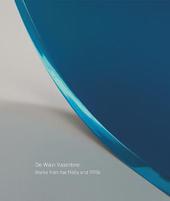
|
De Wain Valentine: Works from the 1960s and 1970s
Hardback
Main Details
| Title |
De Wain Valentine: Works from the 1960s and 1970s
|
| Physical Properties |
| Format:Hardback | | Pages:96 | | Dimensions(mm): Height 292,Width 247 |
|
| Category/Genre | Art and design styles - from c 1960 to now
Sculpture
Individual artists and art monographs |
|---|
| ISBN/Barcode |
9781941701201
|
| Classifications | Dewey:730.92 |
|---|
| Audience | |
|---|
| Illustrations |
Illustrated in colour and black and white throughout
|
|
Publishing Details |
| Publisher |
David Zwirner
|
| Imprint |
David Zwirner
|
| Publication Date |
4 April 2016 |
| Publication Country |
United States
|
Description
A key member of the Light and Space movement in Los Angeles during the 1960s and 1970s, De Wain Valentine is distinguished in particular by his in-depth understanding of synthetic materials and his ability to transform industrial products into artworks that investigate the seductive power of light, transparency, reflection, and surface. Published in conjunction with his critically lauded 2015 exhibition at David Zwirner, New York, De Wain Valentine: Works from the 1960s and 1970s focuses on the artist's pioneering achievements in polyester resin. This is a new scholarly text by Robin Clark on Valentine's production from this period details his personal history and his innovations with this material. Influenced by the vast California landscape, he was initially confronted with material limitations: at the time, polyester resins could not be poured in volumes exceeding fifty pounds. Not willing to accept this restriction, Valentine partnered with Hastings Plastics in 1966 to create an entirely new resin that could be cast in larger quantities. The resulting material, known as Valentine MasKast Resin, allowed the artist to dramatically increase the scale of his work. With its inherent ability to contain and reflect light, while maintaining a powerful luminous dimension, polyester resin would form the foundation of Valentine's practice. The catalogue includes rich color plates of Valentine's "Columns," corporeally scaled sculptures cast in colored polyester resins that recede from a wider base up to a narrow tip; his "Circles," 6-foot discs that display not only the artist's mastery of geometrical form, but also highlight his command of color in sculpture; and a selection of the artist's smaller forms-rings, discs, and double pyramids. The catalogue also features extensive documentation of Double Column Gray (1975- 1976), two massive, identical columns that each stand twelve feet tall. Originally executed for Baxter Travenol Laboratories' in Deerfield, Illinois, Valentine had conceived of two immense vertical columns standing side by side, but because of architectural limitations, Valentine was forced to install the two slabs on their sides. Forty years after its initial conception, the exhibition at David Zwirner represented the first time this work was presented in its intended configuration.
Author Biography
De Wain Valentine was born in 1936 in Fort Collins, Colorado. He received both a BFA (1958) and an MFA (1960) from the University of Colorado, Boulder, and in 1958 he attended the prestigious Yale Norfolk Summer School of Art in Connecticut. A key member of what is often referred to as the Light and Space movement, Valentine is distinguished in particular by his in-depth understanding of synthetic materials and his ability to transform these industrial products into artworks that reveal his fascination with light, transparency, reflection, and surface. Robin Clark is Director of the Artist Initiative at the San Francisco Museum of Modern Art, where she leads interdisciplinary collection research projects that involve long-term collaborations with participating artists. She is an art historian and curator whose scholarship focuses on the intersections of contemporary art and architecture and the conservation of modern materials. She was assistant curator and a contributing author to the Eva Hesse retrospective exhibition and catalogue produced by the San Francisco Museum of Modern Art (2002) and was curator of the Currents exhibition series at the Saint Louis Art Museum (2002-2007). Her more recent exhibitions and publications include Automatic Cities: The Architectural Imaginary in Contemporary Art (2009) and Phenomenal: California Light, Space, Surface, part of the Getty's Pacific Standard Time initiative (2011). For catalogues published by David Zwirner Books, Clark contributed an essay to John McCracken: Works from 1963-2011 (2014).
Reviews"[Valentine's] work seems to herald the current flirtation between art and technology. And indeed, Valentine's almost glowing forms--likened to mandalas in a 1979 feature in this magazine--seem to have anticipated the Apple aesthetic of Zen acolyte Steve Jobs."--Wendy Vogel "Art in America" "Highly reflective yet transparent, fragile yet satisfyingly dense, industrial yet evocative of nature, Valentine's resin is far more complex than the simplicity of his geometric forms might suggest."--Meredith Mendelsohn "Architectural Digest" "Several impressive, perfectly disc-shaped sculptures in blue, red, and gold mysteriously stand on their own, without any support."--Brian Boucher "Artnet News" "The mystery of the installation of the 'Circles' is part of their impact--they are beautiful because they are sometimes tough to suss out mentally."--Alex Greenberger "Artnews" "These crystalline objects are fascinating to behold for their prismatic effects and for the tantalizing sense of cosmic import they so sumptuously embody."--Ken Johnson "The New York Times"
|